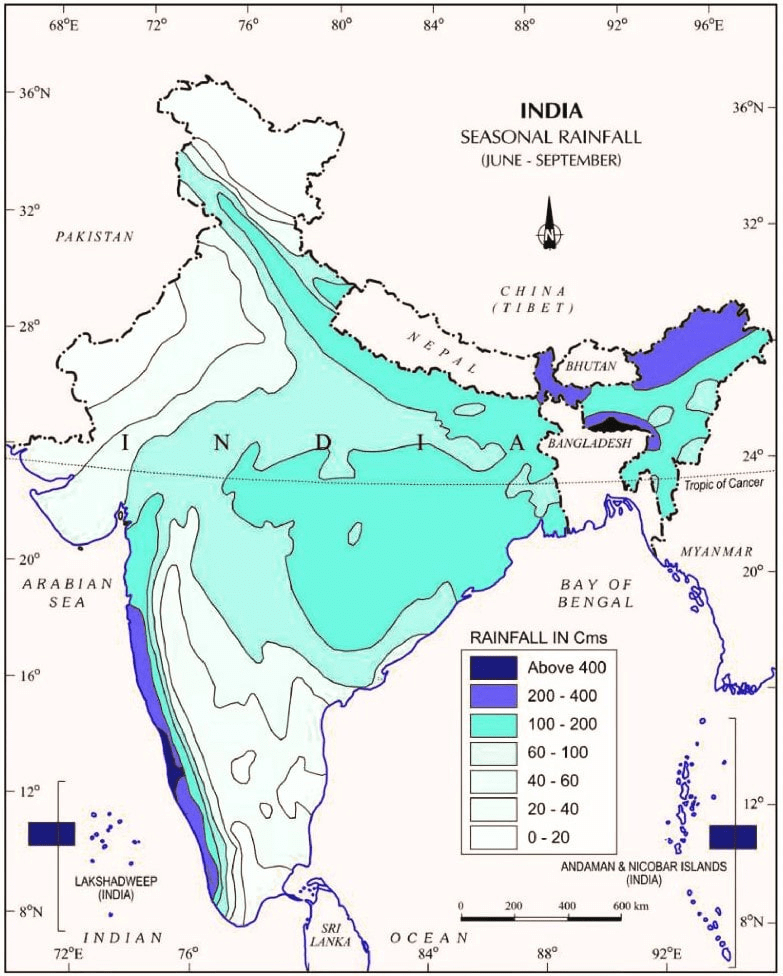Class 9 Exam > Class 9 Notes > Social Studies (SST) Class 9 > Detailed Chapter Notes (Part - 2) - Climate
Class 9 Geography Chapter 4 Notes - Climate
| Table of contents |

|
| Advancing Monsoon (The Rainy Season) |

|
| Retreating/Post-Monsoons (The Transition Season) |

|
| Distribution of Rainfall |

|
| Monsoon As A Unifying Bond |

|
| Key Terms |

|
Advancing Monsoon (The Rainy Season)
Formation and Movement
- By early June, an intense low-pressure area forms over the northern plains of India.
- This attracts southeast trade winds from the southern hemisphere.
- These winds cross the equator and turn into southwest monsoon winds.
- As they pass over warm oceans, they collect a lot of moisture.
- These winds are strong, blowing at about 30 km/h.
- They cover most of India within a month, except the far northwest.
 The Onset of South West Monsoon Rainfall During Southwest Monsoon
The Onset of South West Monsoon Rainfall During Southwest Monsoon
- Brings a complete change in weather across India.
- Western Ghats receive very heavy rainfall (more than 250 cm) on the wind-facing side.
- Deccan Plateau and Madhya Pradesh also get some rain, even though they lie in rain shadow areas.
- The northeastern region gets the most rainfall in the country.
- Mawsynram in the Khasi Hills receives the highest average rainfall in the world.
- Rainfall in the Ganga valley decreases from east to west.
- Rajasthan and parts of Gujarat receive very little rain.
Breaks in Monsoon
- The monsoon has wet and dry spells, called monsoon breaks.
- Rain doesn’t fall every day—it comes in intervals.
- These breaks are caused by the movement of the monsoon trough (a low-pressure zone).
- When the trough is over the plains, those areas get good rain.
- When it shifts closer to the Himalayas, the plains stay dry and mountain areas get heavy rain. - Heavy rains in mountain areas can cause floods in the plains.
Role of Tropical Depressions
- Tropical depressions form in the Bay of Bengal and move along the monsoon trough.
- These systems affect the amount and duration of rainfall.
- They can cause floods in some areas and droughts in others.
Uncertainty of Monsoon
- The monsoon is unpredictable and irregular in timing, strength and duration.
- Causes floods in one region and drought in another.
- Its irregular pattern often disrupts the farming schedule of millions of Indian farmers.
Question for Detailed Chapter Notes (Part - 2) - ClimateTry yourself:Which winds brings widespread rainfall over the mainland of India?
View Solution
Retreating/Post-Monsoons (The Transition Season)
Monsoon Withdrawal
- In October-November, as the sun shifts southward, the monsoon trough weakens over the northern plains, leading to the development of a high-pressure system.
- The southwest monsoon winds gradually diminish, causing the monsoon to withdraw from the Northern Plains.
- October and November signify a transition from the rainy season to drier winter conditions, marked by clear skies and a shift to drier weather patterns.
 Retreating Monsoon
Retreating Monsoon
October Heat
- During October, India experiences high temperatures and humidity, known as the 'October heat' phenomenon, which can make the weather oppressively hot.
Cyclonic Activity
- In late October, temperatures in northern India begin to decrease rapidly as low-pressure conditions move from northwestern India towards the Bay of Bengal.
- By early November, low-pressure conditions in the Bay of Bengal lead to the formation of cyclonic depressions over the Andaman Sea.
- These cyclones often cross the eastern coasts of India, bringing heavy rain and causing significant damage.
Impact of Cyclones
- The deltas of the Godavari, Krishna, and Kaveri rivers, as well as the coastal areas of Odisha, West Bengal, and Bangladesh, are frequently affected by cyclones, leading to substantial destruction of life and property.
- The Coromandel Coast relies significantly on depressions and cyclones for its rainfall, which plays a crucial role in shaping the region's weather patterns.

Distribution of Rainfall
High Rainfall Areas
- The western coast and northeastern India receive more than 400 cm of rainfall annually.
Low Rainfall Areas
- Western Rajasthan, parts of Gujarat, Haryana, and Punjab experience less than 60 cm of rainfall each year.
- The interior of the Deccan Plateau and the eastern side of the Sahyadris also receive low precipitation.
- Leh in Jammu and Kashmir is another area with very low rainfall.
 Seasonal Rainfall
Seasonal Rainfall
Low Rainfall Areas
- Western Rajasthan, parts of Gujarat, Haryana, and Punjab experience less than 60 cm of rainfall each year.
- The interior of the Deccan Plateau and the eastern side of the Sahyadris also receive low precipitation.
- Leh in Jammu and Kashmir is another area with very low rainfall.
Moderate Rainfall Areas
- Most of the rest of the country receives moderate rainfall.
- Snowfall is generally limited to the Himalayan region.
Rainfall Variability and Its Impacts
- Annual rainfall varies significantly across the country due to the nature of the monsoons.
- High rainfall regions are prone to flooding, while low rainfall areas are susceptible to drought conditions.
Question for Detailed Chapter Notes (Part - 2) - ClimateTry yourself: Which region receives more than 400 cm of rainfall annually?View Solution
Monsoon As A Unifying Bond
- The Himalayas block the cold winds from Central Asia, which helps northern India stay warmer than other places at the same latitude.
- The Peninsular Plateau, surrounded by the sea on three sides, has moderate temperatures due to the influence of the sea.
- Even with these natural effects, there are still large differences in temperature in different parts of the country.

- The monsoon winds bring a shared weather pattern to the whole country.
- These winds change with the seasons and create a regular cycle of different weather conditions.
- Though the rainfall is not always regular or evenly spread, this variation is a common feature of the monsoons.
- The monsoon plays an important role in shaping India’s land, plants, animals, farming schedule, and festivals.
- People across India eagerly wait every year for the monsoon to arrive.
- The rain brought by the monsoon helps start farming activities all over the country.
- The rivers that carry this rainwater connect various regions and support agriculture across India.
Key Terms
- Weather vs. Climate: Weather describes the short-term atmospheric conditions in a specific place at a specific time, while climate refers to the average long-term weather patterns over a significant period, typically 30 years. This distinction helps in understanding daily weather forecasts versus long-term climate patterns.
- Temperature Variations: The significant differences in temperature across various regions due to factors like geographical location, altitude, and proximity to water bodies. For example, Rajasthan experiences extreme heat, while Pahalgam in Jammu and Kashmir has moderate summer temperatures.
- Precipitation Variations: Differences in the amount and type of precipitation (rain, snow, sleet) that different regions receive based on their climate zones. High variability affects agriculture, water resources, and overall weather patterns.
- Climatic Controls: Factors that influence a region's climate, including latitude, altitude, pressure and wind systems, distance from the sea, ocean currents, and relief features. Each of these factors contributes differently to shaping the local climate by affecting temperature, humidity, and precipitation.
- Latitude and Climate: The position of a place on the Earth’s surface in relation to the equator (latitude) affects its solar radiation intake, influencing its overall climate. Tropical regions near the equator receive more sunlight and have warmer climates compared to polar regions near the poles.
- Altitude's Impact on Climate: Higher altitudes are characterized by thinner air, which can hold less heat, leading to cooler temperatures. This is why mountainous regions typically have colder climates than areas at sea level.
- Pressure and Wind Systems: The movement and interaction of different air pressure systems across the Earth influence weather patterns and climatic conditions. For example, high-pressure systems are generally associated with stable and dry weather, while low-pressure systems can lead to storms and rainfall.
- Continentality (Distance from the Sea): The effect of an area's distance from the sea on its climate, where areas closer to the sea have milder climates and smaller temperature fluctuations compared to inland areas.
- Ocean Currents: Streams of seawater moved by various global wind systems that can significantly influence coastal climates by carrying warm or cold water across different parts of the globe.
- Relief Features: Geographic features like mountains that affect climate by blocking wind and precipitation, creating varied weather patterns on their windward and leeward sides.
- Monsoon: A seasonal wind system that dramatically influences the climate of regions like India by bringing heavy rains during the summer months. The monsoon is crucial for agriculture but also causes significant weather-related challenges like flooding.
- Cyclonic Depressions: Low-pressure areas in the atmosphere that can lead to severe weather conditions, including storms and heavy rainfall, particularly impactful in shaping the seasonal weather patterns in regions like India.
The document Class 9 Geography Chapter 4 Notes - Climate is a part of the Class 9 Course Social Studies (SST) Class 9.
All you need of Class 9 at this link: Class 9
|
55 videos|637 docs|79 tests
|
FAQs on Class 9 Geography Chapter 4 Notes - Climate
| 1. What are the main characteristics of the advancing monsoon season? |  |
Ans. The advancing monsoon season is characterized by heavy rainfall, strong winds, and an increase in humidity. It marks the onset of the rainy season in the region.
| 2. When does the retreating monsoon season typically occur? |  |
Ans. The retreating monsoon season usually occurs towards the end of the rainy season, as the monsoon winds start to weaken and the rainfall decreases.
| 3. How is the distribution of rainfall affected by the monsoon season? |  |
Ans. The monsoon season brings heavy rainfall to the region, resulting in a distribution of rainfall that is essential for agriculture and water resources management.
| 4. How does the monsoon act as a unifying bond in the region? |  |
Ans. The monsoon season affects several countries in the region, leading to shared experiences of heavy rainfall, flooding, and agricultural activities that create a sense of unity among the people.
| 5. What are some difficult words related to the monsoon season that are important to understand? |  |
Ans. Some difficult words related to the monsoon season include 'advancing monsoon', 'retreating monsoon', 'humidity', and 'distribution of rainfall'. Understanding these terms is crucial for comprehending the processes involved in the monsoon season.
Related Searches





















